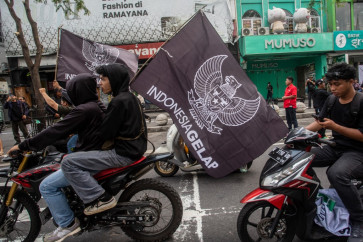Popular Reads
Top Results
Can't find what you're looking for?
View all search resultsPopular Reads
Top Results
Can't find what you're looking for?
View all search results'Hallyu' rising, but Indian pop culture holds strong place in Indonesian hearts
Indonesia has seen a steady increase in K-pop fans over the last two decades, especially among youth in the middle to upper classes
Change text size
Gift Premium Articles
to Anyone
I
ndonesia has seen a steady increase in K-pop fans over the last two decades, especially among youth in the middle to upper classes. However, those of the middle to lower classes in rural areas are still passionate about Indian pop culture.
While Indonesian fans of Hallyu (Korean Wave) plan on traveling to South Korea at least once in their lives, the stars of Indian TV series come to Indonesia to visit fans in their hometowns. Since 2015, Indian TV stars have spent months or even years touring small towns like Cilacap, Central Java, sharing “meet and greets” with thousands of enthusiastic fans.
This February, ANTV brought Ankhita Sharma, Sangeita Chauhan, Samridh Bawa and Sahil Uppal – the stars of popular Indian series Swabhimaan – to Cilacap, where fans welcomed them enthusiastically in the town square.
Beyond Cilacap, the stars visited four other small towns where Indian film and television are immensely popular: the city of Serang in Banten, the regencies of West Bandung and Garut in West Java, and Bandar Lampung, the capital of Lampung province.
Dozens of other Indian stars visited Indonesia in September 2019, including the cast of the Mahabharat TV series, including Shaheer Sheikh.
Sheikh has visited Indonesia several times over the years, including four visits during Ramadan. He can converse in simple Indonesian and enjoys eating rendang (beef stewed in coconut milk) and ayam kremes (batter-fried chicken). The star was even reported to be dating dangdut singer Ayu Ting Ting, which became fodder for the gossip mill of the local entertainment industry.
A Nielsen survey has found that Indonesian viewers of Indian TV programs live predominantly in small towns and fall in the lower end of the income bracket.
“Indian programs have their own market, which is dominated by people in the middle-lower classes and are 35 or older,” Nielsen Media Indonesia executive director Hellen Katherina told The Jakarta Post.
Hellen said that Indian TV series were received well by Indonesian viewers because of many cultural similarities, such as strong family bonds, extreme wealth gaps between the rich and poor and some religious values.
The popularity of Indian TV series even helped turn around the fortunes of a local station. Anindya Bakrie said on his personal blog that Mahabharat and Mahadewa, two popular TV series derived from Indian mythology, had helped ANTV survive.
The Bakrie family owns the private television station, which was the most watched Indonesian TV station in June 2014.
Aside from TV series, which can run as long as 1,500 episodes, Indian movies also have a strong base of avid fans in Indonesia, albeit its demographic is a bit different from Indian TV fans.
According to history website historia.id, the first Indian movie was screened in Indonesia in 1948. Indian cinema marked its heyday in Indonesia in the 1980s and 1990s, and was especially popular among members of the lower class.
Kuch Kuch Hota Hai (1998) was a game changer for Indian movies in Indonesia, expanding its fan base to a younger audience at a time when Indian movies were primarily watched by older viewers. And popular romantic movies propelled Shahrukh Khan to local stardom.
Indonesian actor Muhammad Khan even dedicated his Citra Award, the Indonesian “Oscar”, to the Indian superstar. Born Nurdiyanto in the coastal town of Jepara in Central Java, the Indonesian actor adopted “Muhammad Khan” as a stage name in honor of Shahrukh Khan, whom he had idolized since he was 10.
News presenter Isabella Fawzi, meanwhile, kept her love of Indian movies a secret when she was younger.
As a child, Isabella loved to watch Kuch Kuch Hota Hai reruns.
“At that time, Chiki [her younger sister] and I listened to nu metal, Brit pop. So I was ashamed that I enjoyed watching Indian movies,” she told the Post, laughing.
Her love for Indian pop culture derives in part from her family roots. “One of my great grandfathers came from Lucknow in Uttar Pradesh, India. His name was Oppa Siraj’ul Haque,” she said.
Isabella, the eldest daughter of actress and politician Marissa Haque, said that the older she became, the more she grew to appreciate her Indian ancestry.
“I love the histories of ancient Indian kingdoms, traditional Indian clothes and accessories and the beauty of Indian women. I feel related to them somehow,” she said. “They have character, and they are really proud of their culture. That’s what’s good about them, and it often makes me feel envious.”
Author Mahfud Ikhwan, who is also a fan of Indian movies, said that Isabella was an anomaly, as she was a young personality from the upper middle class who loved Indian pop culture.
“City kids from the middle class, especially those who are well off, are exceptions” to the general demographic of Indian film fans, he told the Post.
Despite his vastly different background from Isabella’s, Mahfud shares her love of Indian movies. Hailing from the coastal town of Lamongan, East Java, he has loved Indian movies since he was a child.
“Indian movies matched our situation at that time. Poor, isolated, many of us were left behind by our parents who had to work far away, which created a kind of communal melancholy that fit the [theme of] Indian movies,” he said.
He said Indian movies were entertaining, provided a form of escapism and offered the illusion of the material things moviegoers did not possess in their real lives.
“Melodrama and spectacle are the determining features of Indian cinema, especially Bollywood [films],” he said.
Mahfud also believed that the demographic of Indian movie lovers intersected with fans of dangdut, the Indonesian musical genre that blends Indian, Arabic and Malay influences.
“We are far removed from exposure to mainstream pop culture. Indian film fans are scattered along the coast, from Aceh to as far as Manado,” he said.










